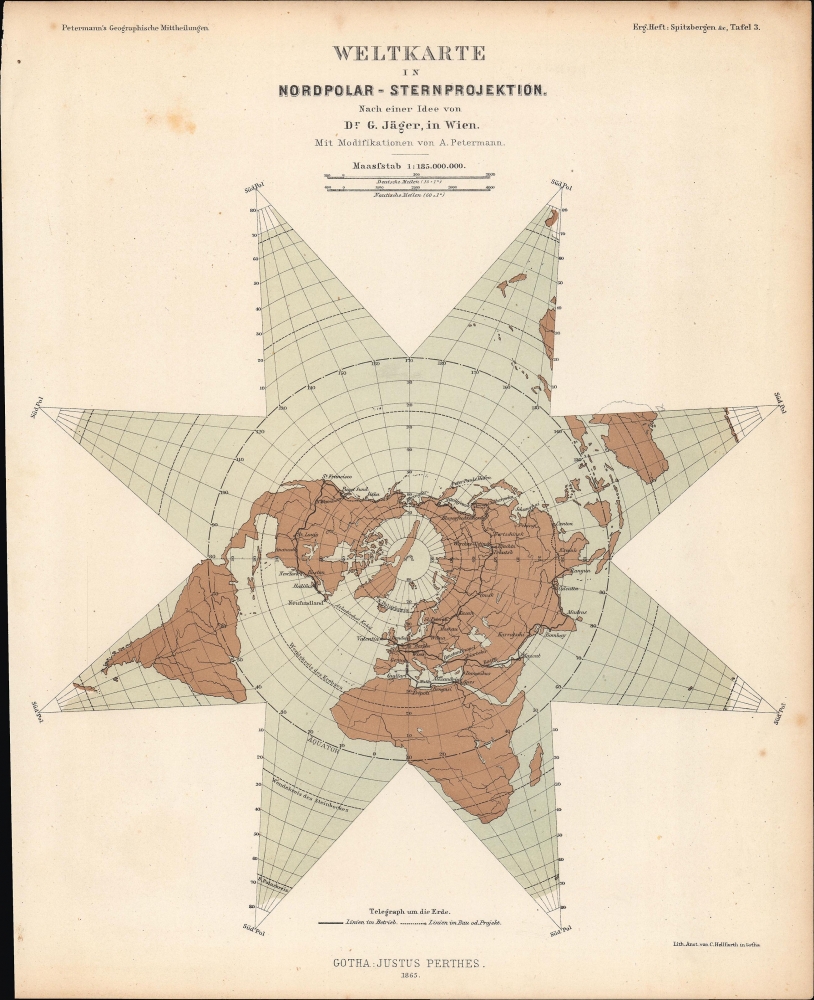1865 Petermann North Polar Projection, World Telegraph Lines
WeltkarteNordpolar-petermann-1865
Title
1865 (dated) 10.5 x 8.25 in (26.67 x 20.955 cm) 1 : 185000000
Description
A Closer Look
Petermann presents a polar projection centered on the North Pole, which nearly resembles an azimuthal equidistant projection, with portions of the globe below the equator splayed out in a star-shape pattern resembling globe gores. Latitude, longitude, and major markers (Tropics of Cancer and Capricorn, Arctic and Antarctic Circles) are noted.Dreams of a Global Telegraph Network
More than its unusual projection, the map highlights the international telegraph system, with established cable lines in solid black and lines under construction or proposed marked with dots. While a transatlantic cable had been laid (by Cyrus Field's Atlantic Telegraph Company) and became operational in 1858, it was slow and unreliable. That first cable was superseded by a much improved second cable, laid across the Atlantic in the year this map was published. Other lines shown as projected here were more ambitious, such as one through the mountains and jungles of mainland Southeast Asia or up the west coast of North America, across the Bering Strait, and through Siberia. The latter, which took form in Western Union's Russian-American Telegraph, gained financing and broke ground in some areas, but proved too difficult and superfluous in any case, as improved lines elsewhere (including transatlantic lines) made such a connection unnecessary. A transpacific telegraph was not established until the early 20th century (the Commercial Pacific Cable Company), by way of Hawaii.Publication History and Census
This map was prepared by Augustus Petermann, based on the concept of Dr. G. Jäger, lithographed by Carl Hellfarth, and published by Justus Perthes to accompany an article ('Spitzbergen und die Arktische Central-Region'), authored by Petermann, that was an 1865 supplementary issue (Ergänzungshefte) to Petermann's Geographische Mitteheilungen. It is independently cataloged among the holdings of the Bayerische Staatsbibliothek, the British Library, and the University of Texas at Arlington.CartographerS
August Heinrich Petermann (1822 - 1878) was a German cartographer. Petermann attended the 'Geographische Kuntschule' (Geographica School of Art), which was started by Heinrich Berghaus with the support of Alexander von Humboldt, in Potsdam beginning in 1839. Students at the school were obliged to work on many of the school's contracts, including maps for several different atlases. Following his time in Potsdam, Petermann relocated to Edinburgh and London from 1845 to 1854, where he gained insight into the commercial aspects of the cartography business. In 1854, Petermann returned to Gotha, Germany and began working with the Perthes brothers publishers. While working with the Perthes brothers, Petermann founded the journal Petermanns Geographische Mitteilungen, published from 1855 until 2014, long one of the most prominent German-language geography journals. More by this mapmaker...
Carl Hellfarth (November 30, 1846 - July 12, 1918) was a German printer. Hellfarth was born in Gotha, Germany. He married Amalie Friederike Marie Möller (1850 - 1916) on June 16, 1873, and they had eight children. Learn More...
Johan Georg Justus Perthes (September 11, 1749 - May 2, 1816) was one of the most important German cartographic engravers of the 19th century. He was born in the Thuringian town of Rudolstadt, the son of a court physician. In 1778, he began working as a bookseller in Gotha. Perthes began his publishing empire shortly thereafter with the 1784 issue of the famed survey of European nobility known as the Almanac de Gotha. In the next year, 1785, he founded the cartographic firm of Justus Perthes Geographische Anstalt Gotha. His son Wilhelm Perthes (1793 - 1853) joined the firm in 1814. Wilhelm had prior publishing experience at the firm of Justus Perthes' nephew, Friedrich Christoph Perthes, who ran a publishing house in Hamburg. After Justus Perthes died in 1816, Wilhelm took charge and laid the groundwork for the firm to become a cartographic publishing titan. From 1817 to 1890. the Perthes firm issued thousands of maps and more than 20 different atlases. Along with the visionary editors Hermann Berghaus (1797 - 1884), Adolph Stieler (1775 - 1836), and Karl Spruner (1803 - 1892), the Perthes firm pioneered the Hand Atlas. When Wilhelm retired, management of the firm passed to his son, Bernhardt Wilhelm Perthes (1821 – 1857). Bernhardt brought on the cartographic geniuses August Heinrich Peterman (1822 - 1878) and Bruno Hassenstein (1839 - 1902). The firm was subsequently passed to a fourth generation in the form of Berhanrd Perthes (1858 – 1919), Bernhard Wilhelm's son. The firm continued in the family until 1953 when, being in East Germany, it was nationalized and run as a state-owned enterprise as VEB Hermann Haack Geographisch-Kartographische Anstalt Gotha. The Justus family, led by Joachim Justus Perthes and his son Wolf-Jürgen Perthes, relocated to Darmstadt where they founded the Justus Perthes Geographische Verlagsanstalt Darmstadt. Learn More...

